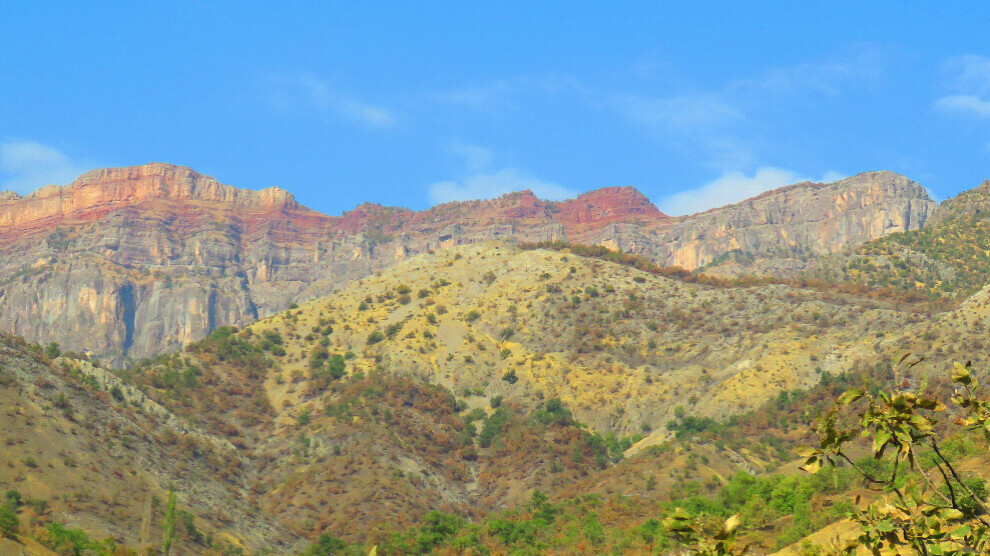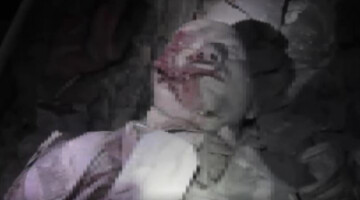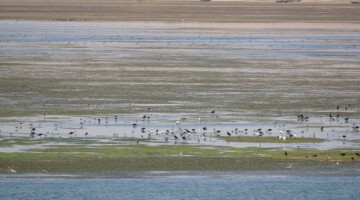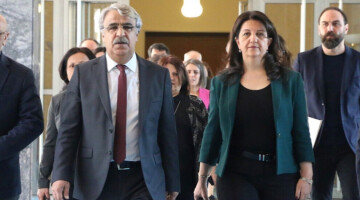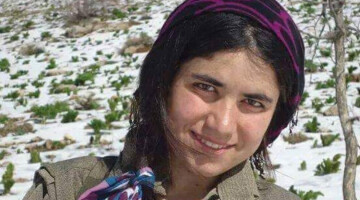On April 23, the indomitable guerrillas were confronting an army which was repeating the bloody history of colonialism in the Avaşîn area. The resistance in Mamreşo, Mervanos, Aris Faris, Werxelê and Basya regions, the sounds of bullets, bombs and ululations echoing in the valleys and mountains, the words that the guerrillas whispered to the most conscientious times of history in their last moments were all crying out a truth whose recognition is still pending... Surrender would lead to betrayal, resistance to victory. The flag of the colonizers would not be planted in the lands where even Alexander the Great failed... This is the story of a freedom struggle carried out by 10 guerrillas who vowed to win a victory on one of the highest peaks of Kurdistan...
The narratives about the 80-day Girê Sor resistance may not be enough to describe even one second of those days of struggle. Nevertheless, this is a reflection of what they did, which started in the red corridors of Girê Sor and flowed to their successors and into the pages of history...
ANF compiled the 80-day Girê Sor resistance from the narratives of Mizgîn Dalaho, Armanc Simko and Têkoşîn Devrim who took part in the resistance. Here is the first part:
Since Girê Sor borders with Avaşîn, it is a very strategic position for both the Turkish forces and us. Located in the Basya region, Girê Sor is home to several hills such as Xwede, Govende, Şehit Serhat, Xapûşkê, Helikopter, Leylek, Sivri and Çarçela, some of which were previously occupied. There is only the Basya Water between these areas and Girê Sor. In fact, almost the entire Girê Sor was surrounded before the invasion attack. Moreover, the aggression of the Turkish army did not begin with this attack. Previously, there was a never-ending military escalation through air strikes, howitzers and mortars constantly fired from outposts. Even the slightest movement around the hill was causing the Turkish army to use a large amount of ammunition and constant shelling. The Turkish army was worried that Girê Sor was still in the hands of the guerrillas.
GIRÊ SOR AND MILITARY POSITIONING THERE
One side of Girê Sor looks out over Govende and the other side faces Çarçela. The part facing Govende is like a natural castle; it is high and has forbidding cliffs. The part facing Çarçela is flatter. Girê Sor consists of four little hills (gupik). Together they form the great hill called Girê Sor. The guerrillas were positioned on the first hill where the battle tunnels are located. The tunnel construction here began in 2014, starting from the lowest part and going up to the summit. This strategic battle position was a large cave (şikeft) with three floors and very long tunnels. Because their tunnels were so long, each floor was separate from the others. The distance between each of the three floors was so long that one felt a different camp on each floor. Most of the gates were also removed from the cliff and used as a shield. Air circulation was no problem as it had too many gates. The structure of the cave was mostly for air strikes and air circulation. These tunnels were completed in 7 years thanks to the sweat and blood of hundreds of guerrillas. The guerrillas who were there during the invasion attack had been in their positions for a year. Hundreds of guerrillas laughed, cried, got angry, shouted, sang folk songs, danced, suffered injuries and fell as martyrs in these tunnels… Therefore, Girê Sor was like a temple with a spiritual meaning as well as a battle ground.
IT WAS NOT JUST A DEFENSE HILL
In Girê Sor, there were many gates and positions where one could protect one's own position and strike the enemy forces. Before the last invasion attack, the Turkish troops were not on firm ground. It was not only a hill where the guerrillas remained in a defensive position, but also an offensive position where the enemy forces were struck repeatedly. In other words, it was a sublime castle that defied technologically advanced weaponry. The Turkish troops were using heavy weapons, mostly against Leylek and other hills. Although the enemy carried out continuous air strikes after each of its offensives, it could not get any results. The enemy was starting to keep pounding the hill when the guerrillas initiated a minor assault. Sometimes, even when some garbage was thrown out, the Turkish army fired howitzers one after another. A paranoid army that can't even tolerate the garbage of the guerrillas... Moreover, the tunnels were not affected much by the air strikes. When there was an air strike, the people inside were not affected by it in any way.
THERE WAS ONLY ONE HILL TO DEFEND ITSELF
The only hill to defend Girê Sor surrounded by the Turkish troops was Süleyman Hill. Girê Sor is located at the end point of Avaşîn province and its front line, for which reason there was no other hill to defend Girê Sor from the back line. There was the Mamreşo hill, but it was not close enough for defense. Due to its location, the hill is half disconnected from the Avaşîn province. The enemy forces could capture images while guerrillas were on the move. All hills, from Çarçel to Sivri, from Leylek to Xapûşkê, Şehit Serhat, Helikopter and Govende, were able to keep track of Girê Sor 24 hours a day. The hill was always targeted on a daily basis. The Turkish army was shooting it directly with tanks or field guns, especially when it received footage from the Sivri Hill. There wasn't a single day without shelling, whether there was footage or not, because the location of Girê Sor and guerrilla actions were posing an obstacle to the enemy forces. For example, while the Turkish army was repairing the roads on the Çarçela slope, the guerrillas were striking them with heavy weapons, making them stop what they were doing.
MATERIAL INFRASTRUCTURE PREPARATIONS WERE INSUFFICIENT
Infrastructure was also a problem due to the hill's remote location from the province. It was necessary to take various risks in order to deal with the infrastructure. The surrounding outposts were no different from hungry wolves looking for their victims. They did not hesitate to attack like barbarians when they saw a guerrilla movement. The guerrillas had to either take risks and complete infrastructure or act according to the seasonal conditions.
The seasonal conditions were not favourable for the guerrillas to complete the infrastructure in 2021. Supplies, ammunition etc. were partially provided during the winter months, but overall, there was a need for more. There was already information that there would be a Turkish military operation against Girê Sor, so some measures were taken. The tunnels were already like fortresses; they were both long and strong. Especially after the Garê attack, new measures were taken in line with the available resources, but when the attack on Avaşîn started on April 23, infrastructure preparations for this war were not complete in Girê Sor. What was complete was the enthusiasm, assertiveness and determination of the fighters. Everyone was ready to resist enemy forces under these conditions.
KEEP YOUR HEART AND BRAIN STRONG
The sound of Turkish helicopters heading towards Mamreşo on the night of April 23 marked the beginning of a new process. When the first attacks began, the guerrillas were already prepared with their weapons, positions, and most importantly, their hearts...
One needed courage for this war. How would one still dare to fight in the midst of all the pain if he had no courage? Kurdish leader Abdullah Öcalan's motto "keep your heart and brain strong" was in the minds of the fighters.
When the invasion attack in the areas of Mamreşo and Mervanos started, all the guerrillas stepped into action. Since explosive materials were scarce, saboteurs were developing new ideas, and assassins were preparing their weapons. All weapons were placed in the positions. Everyone was doing their best to confront the Turkish attack strongly. The hustle and bustle in the tunnels for the completion of the preparations and the atmosphere inside caused great excitement. The fighters were discussing how to hit the enemy forces. Preparations were being made in the tunnels, and the fighters were also concentrating on what could be done for Mamreşo. Some were saying, ‘Let's go out and carry out an action in Sivri or hit the street below Çarçela, we should not give the enemy forces a rest’. All the fighters had the will and desire to do something for Mamreşo. Separate guards were placed on each floor and enemy activity was constantly monitored. When there was a Turkish helicopter mobility, the fighters were trying to help those in Mamreşo and Mervanos by shooting down attack helicopters with a DShK gun of 12.5 caliber. The aim was to assist those who resisted there, trying to attract the attention of the enemy forces. It was actually the most concrete form of the years-long feelings of comradeship gathered in the memory and heart. The enemy was hitting Mamreşo and airdropping troops, but all the guerrillas on the hills around were doing their best to attract the attention of the enemy troops.
EXPERIENCE GAINED FROM CONFLICTS
There were many gates in Girê Sor castle. One could strike the enemy or use heavy weapons without leaving it. For example, using a DShK gun at Girê Sor in the middle of an operation had a psychological effect on the enemy troops. DShK guns with 14.5 calibers were targeting the Sivri outpost from the Çarçela gate. The guerrillas sometimes struck the roads constructed by the enemy forces for military purposes. In this way, they were trying to support their friends on one hand while making preparations on the other. The fighters were gaining experience from what was going on in Mamreşo. This was a new war, and the enemy was trying new tactics. The fighters were constantly following the conflicts in Mamreşo, Zendura and Şehit Serdar and were trying to gain experience for future armed conflicts in their own hills.
MAMREŞO HERITAGE
From April 23 to May 3, an epic resistance led by Serhat, Rûken, Canfeda, Kamuran, Zafer, Xebat and Sarya took place in Mamreşo. Their resistance has passed to and guided us. They fought ferociously to inspire future resistance that would come after them. Mamreşo was the first bullet of the war in Avaşîn and it was a direct hit. The victory would be theirs no matter what. The pain experienced in Girê Sor after the 10-day resistance in Mamreşo and the enemy's chemical attack that killed fighters was indescribable. However, this was only the beginning of the war and they had to keep their spirits up against the hideous enemy. After Mamreşo, the guerrillas said that ‘We will respond with actions, not words’. The idea of retaliation was articulated in all conversations and discussions.
Serhildan was a unit commander. He was constantly shouting in the corridors, changing the lyrics of ‘Berxwedana Serdemê" ballad into ‘Berxwedana Girê Sor’, cheering all his friends up. Indeed, a guerrilla retaliation was serious. All the guerrillas kept saying ‘This hill will be a graveyard for the enemy’.
BEFORE THE ATTACK ON SULEYMAN HILL
The guerrillas, friends, had left Suleyman Hill during the winter. Many guerrillas were unaware that the hill had been evacuated because it would be held again in the spring. Armanc and Baz were set to go there in the spring, and the Turkish attack began on the very day when they were on their way there. The next day they nevertheless reached the hill. Preparations were made there, including planting mines. Since there were no sabotage materials in Girê Sor, explosives were brought directly from the Stûnê region. Suleyman Hill was given priority because there were few fighters there and it was an important position. It was the highest hill in the province and dominated especially over Basya and Stûnê. It was known that the enemy would attempt to capture this position in case of a possible Basya attack.
The tunnels of Suleyman Hill were not very solid and it had only three gates. The tunnels were constructed on the summit and its rocks were falling down on their own. It was a strategic hill, but it was better to leave it based on a tactical point of view because of the condition of the battle tunnels. There were limited supplies only for a single unit until the autumn. Since there was an infrastructure problem in Girê Sor, it was decided to transfer the supplies, technical materials and ammunition from Süleyman Hill to Girê Sor. Each time, a group of fighters went and collected the supplies there. There was a serious battery problem at that time. The tunnels of Girê Sor were very long. Since no one had a flashlight, the fighters were moving against the walls in the dark. The guerrillas had a hard time in the dark tunnels. Everyone was going with a lighter, which made it impossible to move quickly in the tunnels. There was a plan to bring supplies and batteries from Süleyman Hill. After an attack in Mamreşo, the Şehit Şoreş Camp was surrounded and the needed materials could not be brought from there. They would be brought from Süleyman Hill. Every evening, a group of two fighters was bringing supplies into Girê Sor on their backs. A day or two before the start of the attack, Botan, Özgür and Baz would go to Süleyman Hill and collect batteries and other supplies.
ATTACK ON SULEYMAN HILL
On June 14, the Turkish attack began at around 20:00 when the fighters had already collected the materials and were about to leave. The Turkish troops first struck Girê Sor and Süleyman Hill with howitzers and tanks. Later, Turkish fighter jets struck Süleyman Hill three times and Girê Sor once. Then the helicopter movement started, and the Turkish army landed its troops about 20 times on and around Süleyman Hill. The attack helicopters didn't shell much, but there was a lot of activity. In the meantime, the guerrilla forces were also filming them. The Turkish soldiers must have thought that the hill was empty, so as soon as they arrived, they advanced towards the gates of the tunnels. The Turkish soldiers wanted to lay cables immediately so as to place explosives near the gates. The guerrillas activated the explosives they had previously placed in the area, and it was around 05:00 in the morning when the Turkish soldiers approached near the explosives. When they came right over the explosives, the first explosive was detonated. 3 Turkish soldiers died there and they all fell down the cliffs. A guerrilla footage showed the fall of the soldiers from the cliffs after the explosion.
The guerrillas remained there for two days. The position there was already small and unsuitable for a prolonged battle. It had a gate which the enemy forces had not yet seen. The guerrillas dropped bombs and engaged in a clash for a while. Those in Girê Sor were coordinating the guerrilla action from afar, transmitting the enemy's movement directly to them, and the fighters here were hitting the enemy forces. However, the right decision was to leave this position. Announcements were made constantly for the guerrillas to leave,and a DShK gun was fired constantly to help them leave, attracting the enemy’s attention to Girê Sor. Botan was never helpless, and he was offering solutions to his friends. He was very creative indeed. They did not say ‘we are just three people, we can’t do anything anyway’. Three fighters were defending a war position against hundreds of Turkish soldiers and causing enemy casualties with their actions. The guerrillas were both hitting the enemy from inside and detonating the explosives outside, dealing serious blows to the enemy forces.
THEY WERE CONVINCED TO LEAVE
The guerrillas detonated a second explosive targeting the enemy around 21:00. Other explosives weren't in the coverage area of Girê Sor. The three fighters resisted there until the evening, and they were constantly instructed to leave the area. However, all three remained determined, saying that they would not leave and would fight to the very end. They were constantly instructed to get out of there and they were also told that reinforcements would be sent. The next evening, they were convinced to get out of there at around 20:00. The Turkish troops had not noticed the Çarçella gate anyway. Baz went out first, and Özgür and Botan went after him. Just as the guerrillas were leaving, someone noticed them. They were not sure whether he was a village guard or a soldier. Özgür called out to Botan, ‘We have been noticed’. Botan replied: ‘Just pull yourself down right away’. Most likely, he was a village guard and he saw the guerrillas, but he did not do anything out of fear. In this way, they dropped themselves one level down.
FIRST GUNDÊ HERKÎ, THEN GIRÊ SOR
It was a very tough road after leaving the hill. It was not easy to get out of the enemy lines and to walk that long road without water in the middle of summer. Since they did not know exactly how the enemy troops were positioned in the area, they had stopped somewhere below the enemy forces. They had contacted Girê Sor with a wireless device. They asked if there were Turkish soldiers in Girê Spi. The answer was ‘yes’. In fact, they were only 400 meters away from the Turkish troops, but the enemy forces did not notice them. They heard dogs and soldiers and changed their positions without being captured by a camera. They later moved to Gundê Herkî. They managed to reach Girê Sor safely on the night of June 17. There was great happiness upon their arrival at Girê Sor. Leaving a small hill like Suleyman and surviving chemical gases and enemy troops had a very different meaning.
They gained experience within a few days from what had happened there. They understood the enemy's course of action. During this process, Botan always kept saying ‘We must reach Girê Sor, our friends need us, we must also take batteries’. Botan was injured, but a person could get great power from his will. Özgür, on the other hand, always said, ‘I couldn't make sense of the construction of these positions in the past, but after what happened to us at Suleyman Hill, I understood what it meant’. Now he was insisting on building a position. They are now more experienced. After them, the number of guards was increased and more precautions were taken at the gates. They were now ready and waiting for the enemy to come.
To be continued…

